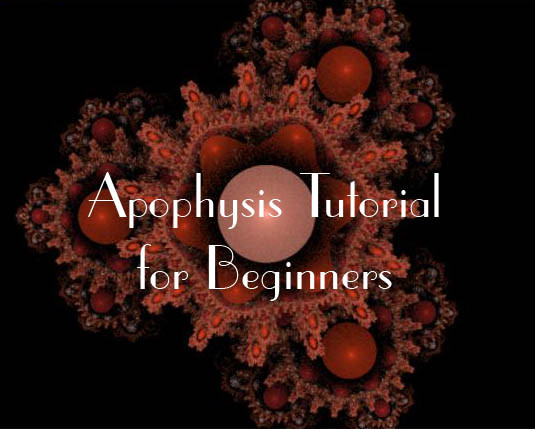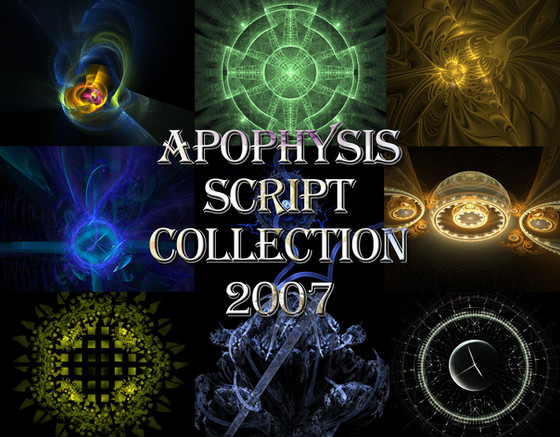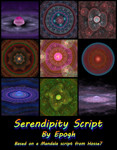HOME | DD
 ChaosFissure — Starting Out: Learning Apophysis
ChaosFissure — Starting Out: Learning Apophysis

Published: 2014-01-24 21:15:30 +0000 UTC; Views: 13519; Favourites: 170; Downloads: 1273
Redirect to original
Description
I promised a guide to beginning fractal artwork using Apophysis, and here it is. No, it's not a video tutorial -- I made the executive decision to make it written, because it would be a one-time download and could be used offline, plus I find it easier to explain these concepts in a static context, and had troubles slowing myself down enough to put them into video.
I hope you still are able to find use out of this tutorial! Here are some useful resources to pursue as well!
//-------------------- Apophysis Itself --------------------//
The program itself.
sourceforge.net/projects/apoph… - Newest version of Apophysis, though I do not recommended due to possible incompatibilities with prior versions and things discussed in this tutorial, as well as possible interface differences.
sourceforge.net/projects/apoph… - for older versions of Apophysis, including the versions I use. I recommend using Apophysis 7x v15C for 64-bit, and Apophysis 7x v15B for 32-bit. Although you cannot use plugins in this version of the 64-bit system, I generally use 32-bit versions if I need plugins because it's harder to find the 64-bit DLL's, and there are a lot more written for the 32-bit version.
//-------------------- Plugins --------------------//
Links to useful plugin packs, gallery sections of DeviantArt users who have made plugins, or individual plugin packs. All are 32-bit plugins unless otherwise specified, meaning you need to use a 32-bit Apophysis build to use them.
phoenixkeyblack.deviantart.com… - The #Aposhack plugin pack, which includes a large number of plugins that are commonly used. DO NOT PUT THEM ALL IN YOUR PLUGINS FOLDER OR APOPHYSIS WILL CRASH. Only use the ones you need!
fav.me/d3j8rvx - FarDareisMai gutted the Aposhack Plugin Pack above to contain ones that were commonly used and hopefully shouldn't crash Apophysis you put them all in your plugins folder.
zy0rg.deviantart.com/gallery/3… - zy0rg 's plugins for Apophysis can be found here. Out of the list, I personally use the Blur Package the most.
xyrus-02.deviantart.com/galler… - Xyrus-02 's plugins for Apophysis can be found here.
zueuk.deviantart.com/gallery/4… - Zueuk 's plugins for Apophysis can be found here.
michaelfaber.deviantart.com/ga… - MichaelFaber 's plugins for Apophysis can be found here.
//-------------------- Tutorials and Things --------------------//
Other tutorials to take a look at.
Shameless spam of my own tutorials:
- fav.me/d6rllvj - Rendering and presentation strategies.
- fav.me/d5omsp6 - Linear Triangulation Tutorial
- fav.me/d5gyh1i - Bokeh Tutorial
- fav.me/d4tqjj4 - Fractal "Painting" - setup and Apo Rendering.
- fav.me/d4u8uf9 - Fractal "Painting" - Chaotica Rendering
Some tutorials from C-91
- fav.me/d5gsbxb - How to go about tweaking parameters
- fav.me/d5r545c - Spherical Plants
Some stuff from Fiery-Fire
- fiery-fire.deviantart.com/art/… - Interface guide for Apo 2.x.x
- fiery-fire.deviantart.com/art/… - Spherical tile setup.
- fiery-fire.deviantart.com/art/… - Some complex but cool tile setup.
- fiery-fire.deviantart.com/art/… - JDiscs (Julian Discs).
clairejones.deviantart.com/gal… - A collection of tutorials from ClaireJones .
lindelokse.deviantart.com/gall… - A collection of tutorials from lindelokse .
pillemaster.deviantart.com/gal… - A collection of tutorials from pillemaster .
fractaldesire.deviantart.com/g… - A collection of tutorials and resources from FractalDesire .
satania.deviantart.com/gallery… - A collection of tutorials and resources from SaTaNiA
meckie.deviantart.com/art/Simp… - 3D Julian Tutorial by Meckie
fav.me/d30940s - Spherical Disc Tutorial by heavenriver
__________________________________________________________
This tutorial, may not be uploaded, reuploaded, destributed, redistributed, modified, or claimed as your own without my prior, written permission. © ChaosFissure 2014
Related content
Comments: 73

nice tut!
one remark:
zoom slider does not do anything weird! it is the same as scale but it recalculates flame while scale only... well, scales it up or down (without recalculating its quality).
if you have faster comp then i recommend to use zoom = 1. it makes editing much easier (less grainy preview) and does not slow down your comp too much.
setting the render to zoom = 0 / quality = 10000 is the same as to zoom = 1 / quality = 2500, you can test it...
👍: 0 ⏩: 1

It's not as if I don't understand what zoom does, nor lack a computer able to use it quickly; it's that I don't like how it forces slowdown in the previewing. From my experience, I often forget I am using zoom, and end up wondering why previews take forever to render and display on the screen. I personally prefer to set density directly rather than having it automatically scale by zoom, as generally I find that I can get away with using a lower density than what is calculated with zoom to obtain faster previews and get back to the creative process more quickly.
👍: 0 ⏩: 1

sure, it depends on quality and size of display unit, power of processors, state of users eyes, style s/he likes to do, usual workflow speed etc... i wanted newcomers to know and try
👍: 0 ⏩: 1

The tutorial is based off of my own experiences and advice. While there are many different workflows, I am simply describing what I am most familiar with, and what I personally feel is necessary to use the program without introducing too much complexity. I understand that I'm presenting my own personal workflow, and while I do not mind suggestions that could be used to improve the tutorial I have, I do not feel that the recommendation is very beneficial to new users.
Zoom is a function that slows down my workflow (even on a 64-bit, 4.5ghz 8-core i7 using native, asm-based variations), and the general consensus I have heard from other users I talk to frequently is that they don't use zoom either.
While I could check the source code, I am strongly under the impression that zoom does nothing other than a combined scale/density adjustment, and as I address both of those topics in my tutorial, zoom only complicates the understanding of how the program works. By removing its functionality, I only need to cover a relationship between density and scale in the tutorial, making the role of density easier to understand.
Additionally, there are no guarantees that using zoom will remove the need to change the density, and if users need to change the density in the first place, I feel that they would have more control doing it manually than via zoom, and also be able to go to a lower density at the same resolution in a single step for speed (without needing to use decimal density, which I find would heavily, and needlessly, complicate things ), rather than needing to do the math to get back to the same spot (which again adds complexity).
👍: 0 ⏩: 0

Again...
As you say, don't use Zoom or the render is far too long. Use Scale in the Adjust box.
To do this click to the left of the number and drag the little arrows to the right.
👍: 0 ⏩: 0

The only thing I know a little about is making new gradients from either an image or photo using Smooth Palette (last icon at the bottom right corner) in the Gradient box or with ApoMap which is at Source Forge.
ApoMap is easy to use and makes .map gradients for either Apophysis or UF. It also uses any coloured image.
So you don't need Photoshop etc as an intermediary, unless you want to choose only some of the colours in your image.
You can easily make a folder for gradients you've made and access it with Gradient Browser. I've just added all my UF gradients to Apo this way.
Just add the .url gradients folders alongside the others in the Apophysis main folder.
I hope that is clear.
👍: 0 ⏩: 1

The reason I really didn't cover "using any old image file in any software" is because I don't want people lifting gradients from random artwork as a primary source of obtaining coloring schemes. For a beginning tutorial, making mention to additional software than can be used also seems to defeat the purpose of it being a tutorial on a specific piece of software as well -- due to that, I didn't cover the whole UF->Apo gradient copypasting, or custom tools that can be used to manipulate and create gradients.
👍: 0 ⏩: 1

While I honestly wanted to cover All The Things, I didn't want to make any individual tutorial incredibly long, or end up being too confusing to follow for people entirely new to fractal art. There's obviously many things that I didn't cover and probably could deserve tutorials of their own...
👍: 0 ⏩: 1

I downloaded this I think you did well here.
I find Apo too difficult with the limited knowledge I have and it frustrates me a lot not to be able to use it.
Plugins are a problem to me.
I also use it on a Mac with Wine and it's not very good. It's slow and doesn't work smoothly.
I can't use Scripts with that version. There is no button for them although there is a folder inside.
When I have the patience I'll try starting from scratch as you say here.
Thank you for your trouble.
👍: 0 ⏩: 0

Although I'm not new to Apophysis I really don't know very much about it.
I hope I'll learn a few things from this tutorial.
Thank you.
👍: 0 ⏩: 0

All my thumbs up 
👍: 0 ⏩: 1

Don't mention it! It's a tutorial I felt was very straightforward to follow, which I thought made it a very good resource to be mentioned in here 
👍: 0 ⏩: 1

It's fine as is 
👍: 0 ⏩: 0

My goal was to provide a large list of useful tutorials that I felt wouldn't be overly complicated for newer users to understand. The tutorial on tweaking especially is an important concept, I think.
👍: 0 ⏩: 0

It seems I've been disorganized. I made a plugin folder michaelfaber.deviantart.com/ga…
👍: 0 ⏩: 1

Thank you! I'll update both links I have to it accordingly!
👍: 0 ⏩: 0

Thank you as this will be much help to me
👍: 0 ⏩: 1

Let me know what you think of it when you're done!
👍: 0 ⏩: 0

omg, i am gonna study the hell out of this, thanks!
👍: 0 ⏩: 1

You better
Haha, let me know how well it works! I want this to cover the basics -- not necessarily making things, but allowing people to understand how to manipulate and use the program on some level.
👍: 0 ⏩: 0
<= Prev |
























